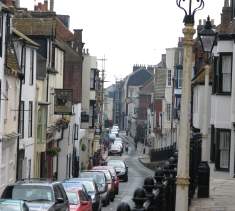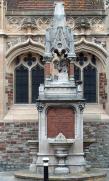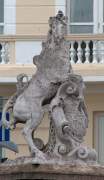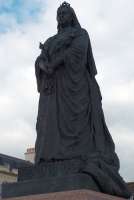 Street in the Old Town, Hastings.
Street in the Old Town, Hastings.
An aesthetic seaside town day out from London, about one and a half hours by train from Charing Cross Station, or less conveniently from Victoria Station.
 Street in the Old Town, Hastings.
Street in the Old Town, Hastings.
Hastings has a good main museum, and two smaller ones, all with at least some Victorian interest. Also part of the historic town survives with antique shops etc, and there is a (very) ruined castle.
From the station, the main museum is rightwards and upwards, along Cambridge Road, the opposite way from the main town by 10 minutes walk. It is called the Hastings Museum and Art Gallery, and is much undiscovered by many visitors to the town.
The museum has a good display of 19th Century marine paintings as part of a collection of scenes in the Hastings area. Among Victorian paintings, we may mention the work of William Henry Borrow, based for much of his career in Hastings, and whose work may also be found in the two smaller museums in the town. William Henry Hunt was also much associated with Hastings and we may note characteristic work by H. W. B. Davis, Walter Sickert, Shannon and Shee.
Most impressive among the collections of the Museum is the Brassey Durbar hall, reconstituted from the 1886 Great Colonial and Indian Exhibition at South Kensington. The two-storey Durbar Court (Hall) was taken from the Indian Palace in the exhibition, acquired by Lord Brassey, a railway magnate, and presented by his successor to Hastings Museum. The ornate carved woodwork is by Muhammad Baksh and Juma of the Punjab. Displays include models of Indian workers, jewellery, and a small ethnographic collection. Among much else is a bust of Brassey by M. Wagmueller, dated 1868. (The Jaipur Gate to the same exhibition is now at Hove.)
Also in the museum is a collection of 16th-18th century firebacks, some with crude mythological scenes in relief, and a pottery collection centred round the Vicat Cole bequest of 18th and 19th Century pottery, with local brown slipware, colourful and elaborate work from the Rye Pottery, and small displays of other work of oriental and classical early English origins. Completely irrelevant mention must also be made of the exhibition relating to Grey Owl, a red Indian celebrity who turned out to be an impersonator originally from Hastings, a certain Archibald Belamey (1888-1939).
 Countess of Waldegrave Fountain.
Countess of Waldegrave Fountain.
As mentioned, there are two smaller museums in Hastings of arty interest - the Old Town Museum and the Fishermen's Museum. The Old Town Museum has various drawings, watercolours and a few oils. Work displayed includes studies of Hastings fishermen by Samuel Prout, who had links with the town, as well as works by W. H. Borrow, already met in the main museum, including a lively Hastings Beach. Other notable work includes a small portrait of the artist's daughter by William Henry Hunt. Historical exhibits and several 19th Century ships' prows are also in the collections of this charming, modest museum.
The Fishermen's Museum, housed in a small former fishermen's church of 1854, has lots of mixed quality pictures and prints,
and in particular there is a good opportunity to further make the
acquaintance with the works of William Henry Borrow. Close to that museum is
the series of tall and narrow 19th Century wooden net-drying huts.
In the Old Town, St. Clement's Church is of interest, partly because Rossetti
was married here. On the sea front is much Georgian and Victorian architecture, in particular
the excellent Pelham Crescent by the architect Joseph Kay, dating from the 1820s, and thus contemporary with the Nash terraces
in London. Approximately parallel to this, in the rear courtyard or carpark of a large store, are a pair of very corroded limestone
sculptures of a unicorn and lion, heraldic in style from the Royal Coat of Arms (see this page for more
on heraldic unicorns). Apparently they are the work of the sculptor J. G. Bubb.
In the main part of the town ('New Town'), Holy Trinity Church, on Robertson Street, dates from
1851-9 and is by Teulon. Next to is is an ornate fountain to Sarah, Countess
of Waldegrave, with much corroded limestone statue, erected by public
subscription 1861 (see picture further up the page).
Half a minute away on Claremont is the Brassey Institute, now containing the town library. A good building by the architect Vernon,
dating from 1878, it combines a blocky Gothic tower on one side with otherwise largely Italianate detail. It is worth exploring -
the porch has a small mosaic frieze, and there are a couple of portrait sculptures inside. Most interestingly, though,
in the lending library are two long paintings by E. A. Armitage, from 1874, showing processionals of heroines from the past.
The Town Hall is in Queen's Road, a castellated effort in sandstone by Henry Ward. Opposite is the former Gaity Cinema, once
the Marine Palace of Varieties, dating from just before 1900. The modest Queen's Arcade runs underneath.
A little inland is the White Rock Cafe, some sort of leisure centre, which has half a dozen roundels showing
coloured cherubic figures, confident decorative work by the essentially 20th century sculptor Gilbert Bayes.
Facing the sea and walking rightwards or westwards along the shore is a pleasant stroll to
Warrior Square (1850s-60s, though sadly some demolition has been undertaken), where facing the sea is a bronze statue of Queen Victoria (1902), one of several
versions of the subject by F. J. Williamson. The date is 1902 and this is a characteristic work by the sculptor.
The modest pier which divides Hastings proper from the St Leonards/Warrior Square district is by E. Birch.
Warrior Square has its own station on the line from London, and visitors alighting here
can visit the main street with its several antique shops before walking
along the beach through to central Hastings.
Sculpture pages // Statues in English towns
// Eastbourne
Visits to this page from 23 Nov 2011: 7,797
Also in Hastings
 The Hastings Unicorn, by J. G. Bubb.
The Hastings Unicorn, by J. G. Bubb.
 Queen Victoria, by F. J. Williamson.
Queen Victoria, by F. J. Williamson.